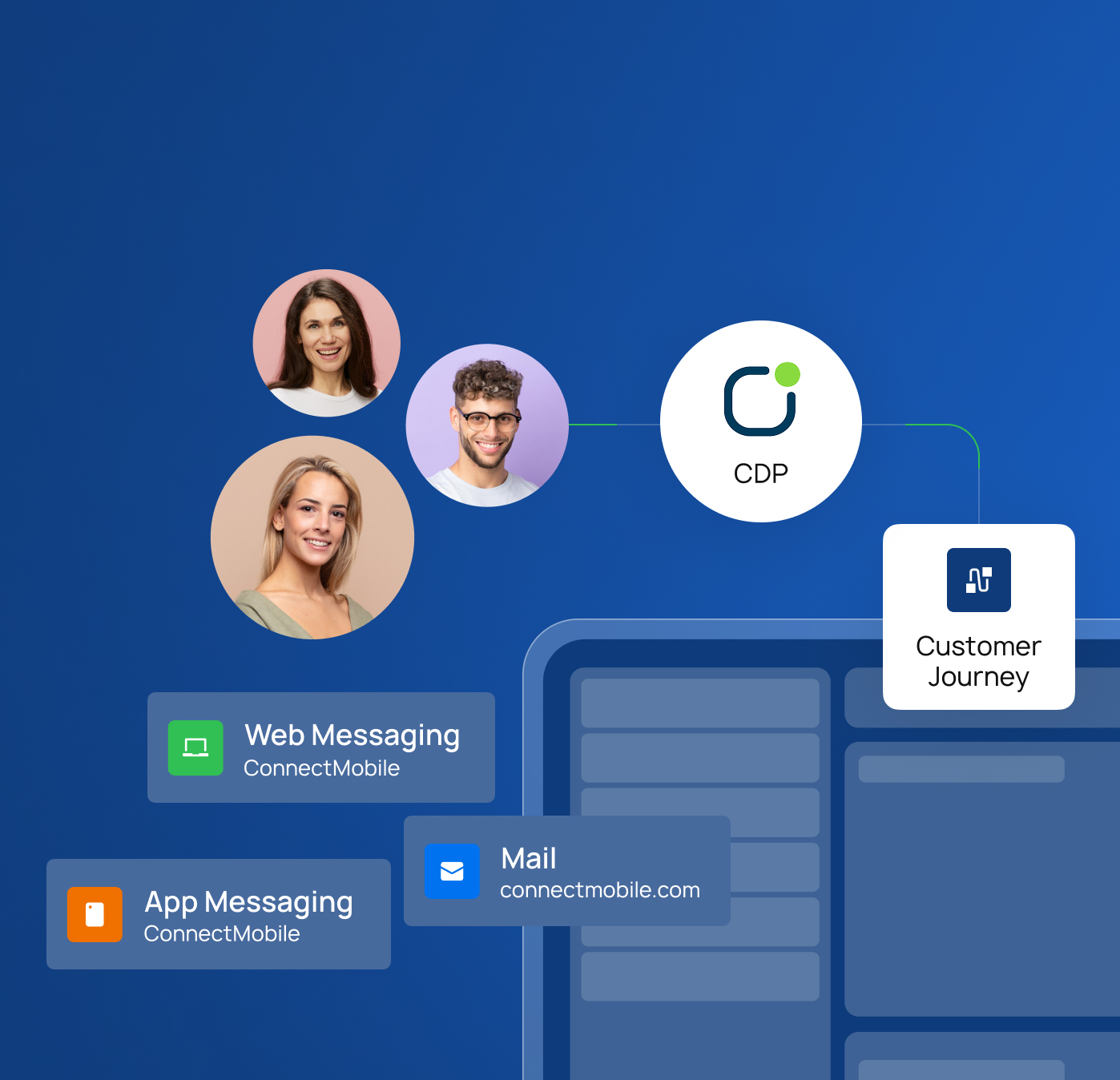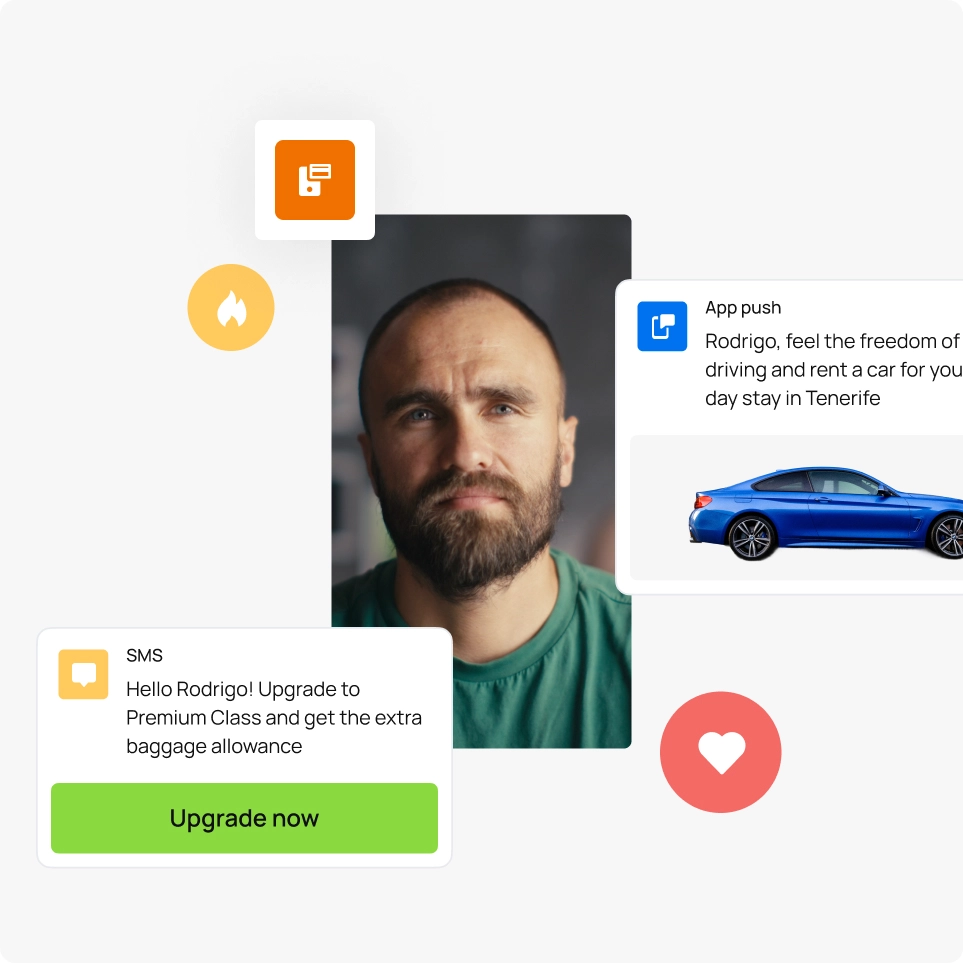Customer Engagement Platform vs. CRM: The Ultimate Guide for 2025


I. Introduction
In the hyper-connected landscape of 2025, the modern customer operates with a new set of non-negotiable expectations. They anticipate, and indeed demand, a brand experience that is seamless, deeply personalized, and unfolds in real-time across every conceivable channel. They might discover a product on Instagram, research it on a laptop, add it to their cart on a mobile app, and ask a question via a website chatbot. To them, this is all one continuous conversation with a single entity. They have no patience for disjointed experiences where the marketing team is unaware of a recent customer service interaction, or where the website doesn’t reflect their known preferences. This expectation for effortless, omnichannel fluency has placed immense pressure on businesses to orchestrate their customer interactions with flawless precision. The brands that succeed are those that can make every touchpoint feel like a natural continuation of a single, unified relationship.
However, navigating the technology required to deliver this experience has become a monumental challenge in itself. Business leaders and marketing teams are often confronted with a bewildering alphabet soup of technology acronyms: CRM, CDP, CEP, CSP. Each platform promises a solution to the customer puzzle, yet their functions, while sometimes overlapping, are fundamentally distinct. This confusion is more than just a semantic issue; it has profound operational consequences. Choosing the wrong tool for the job—or failing to integrate the right tools correctly—inevitably leads to the very problems these platforms are meant to solve. It creates stubborn data silos where valuable customer information is trapped within departmental systems. It results in fragmented customer journeys where a user receives contradictory messages or has to repeat themselves to different teams. Ultimately, it leads to frustrated customers, demoralized employees, and a significant waste of time, money, and resources on a tech stack that works against itself.
This guide is designed to be your definitive resource for cutting through the noise and demystifying the modern customer technology stack. We will meticulously dissect these critical platforms, moving beyond jargon to clarify their core functions, primary users, and strategic purpose. By understanding the fundamental differences between a Customer Relationship Management (CRM) system, a Customer Data Platform (CDP), a Customer Engagement Platform (CEP), and a Customer Service Platform (CSP), you will be empowered to make informed decisions about your own technology investments. Our goal is to provide a clear framework for evaluating your needs and to help you understand which solution—or, more often, which combination of solutions—is right for building a truly modern, effective, and scalable customer engagement strategy that can meet and exceed the lofty expectations of today’s consumer.
II. Foundational Platforms: Understanding the Data Layer
Before a business can effectively engage with its customers, it must first understand them. This understanding is built upon a foundation of data. Two key platforms form the bedrock of this data layer: the Customer Relationship Management (CRM) system and the Customer Data Platform (CDP). While both are crucial for managing customer information, they serve fundamentally different purposes and are designed for different primary users. Confusing their roles is one of the most common pitfalls in building a marketing technology stack. A CRM is designed to manage relationships, while a CDP is designed to unify data from all sources to create a complete customer picture.
A. What is the difference between a CRM and a Customer Data Platform (CDP)?
Customer Relationship Management (CRM): The System of Record for Interactions
At its core, a CRM is a system of record designed to manage and track a company’s direct interactions with its customers and prospects. Think of it as the central hub for relationship-oriented data. Its primary users are customer-facing teams like sales, customer service, and business development. The data within a CRM is predominantly first-party data that is often entered manually or through direct system integrations. This includes contact information (name, email, phone number), communication logs (records of calls, emails, and meetings), sales pipeline data (deal stages, potential revenue, close dates), and customer service history (support tickets, issue resolutions).
The key goal of a CRM is to provide a single source of truth for the history of a customer’s relationship with the company. It answers the question, “Who is this customer, what have we sold them, and what have we talked to them about?” It is an indispensable tool for managing sales funnels, tracking customer support issues, and ensuring that any team member can quickly get up to speed on the history of a particular account. In essence, a CRM is like a customer’s digital file folder or a highly detailed, collaborative address book. It is fundamentally reactive, providing a historical record of what has already happened in the customer relationship.
Customer Data Platform (CDP): The Central Nervous System for All Customer Data
A Customer Data Platform, on the other hand, was born out of the need to solve a different, more complex problem: the fragmentation of customer data across dozens of different systems. A CDP’s core function is to ingest, cleanse, and unify customer data from all available sources—both online and offline—to create a single, persistent, and comprehensive profile for each individual customer. Its primary users are marketing teams who need a deep, holistic understanding of customer behavior to power personalization and campaign orchestration.
The data a CDP handles is far more diverse than that of a CRM. It collects behavioral data from your website (pages viewed, time on site), mobile app (features used, session length), e-commerce system (products browsed, items added to cart), social media platforms, and point-of-sale (POS) systems. It can also ingest data from your CRM, email service provider, and even third-party data sources. The CDP then uses a process called identity resolution to stitch all of this information together, linking an anonymous website visitor to a known customer in the CRM and a loyalty member in the POS system. The result is a true 360-degree view of the customer. The key goal of a CDP is to answer the question, “What does this customer do, what are they interested in, and what are they likely to do next, based on their behavior across all our touchpoints?” If a CRM is the file folder, the CDP is the central nervous system that connects the brain (strategy) to every sensory input (data source) in real-time, making that data immediately available for activation.

III. The Action Layer: Defining the Engagement Engine
Once a business has a unified, 360-degree view of its customers thanks to a robust data layer (ideally powered by a CDP), the next critical question is: “What do we do with this understanding?” Simply collecting and unifying data is a passive exercise; the real value is unlocked when that data is used to power intelligent, personalized, and timely interactions. This is where the “action layer” of the technology stack comes into play, and its most powerful modern incarnation is the Customer Engagement Platform (CEP). A CEP is the engine that transforms static customer profiles into dynamic, two-way conversations, orchestrating communications across the myriad of channels where customers now spend their time.
A. What is a Customer Engagement Platform (CEP)?
A Customer Engagement Platform (CEP) is a software solution designed to facilitate, manage, and optimize the full spectrum of customer interactions across multiple channels in a cohesive and orchestrated manner. It is the command center for all customer-facing communications. While a CDP’s primary job is to aggregate and understand data, a CEP’s primary job is to act on that data. It sits on top of the data layer, using the rich, unified profiles to create, deliver, and continuously improve personalized communications and automated customer journeys. A CEP is not just about sending messages out; it is fundamentally about fostering continuous, two-way conversations that build relationships over time.
A key characteristic of a true CEP is its omnichannel nature. It is designed to manage both inbound and outbound communications within a single, integrated framework. Outbound channels are those initiated by the brand, such as push notifications, email campaigns, SMS alerts, and WhatsApp messages. Inbound channels are those initiated by the customer, such as queries to a website chatbot, interactions with an AI agent, or browsing behavior on a mobile app. A CEP can seamlessly connect these two worlds. For example, a customer’s inbound query to a chatbot can trigger an automated outbound follow-up via email, or a customer’s real-time browsing behavior can trigger a personalized push notification.
The primary goal of a CEP is to move beyond simple, transactional marketing campaigns towards building lasting customer relationships that drive loyalty and increase lifetime value. It seeks to answer the strategic question, “How can we best interact with this customer, on their preferred channel, at this exact moment, to provide the most value?” By centralizing all communication channels and powering them with unified customer data, a CEP enables a level of personalization and contextual relevance that is impossible to achieve with a collection of disconnected, single-channel tools. It allows marketers to design complex, automated journeys that adapt to each user’s behavior, ensuring that every message is a relevant and welcome continuation of an ongoing conversation, rather than an isolated and disruptive interruption.

IV. Key Distinctions: Choosing the Right Tool for the Job
Understanding the individual definitions of CRM, CDP, CEP, and CSP is the first step. The next, more critical step is to grasp their distinct roles in relation to one another. A common source of failure in technology adoption is using a tool for a purpose it wasn’t designed for—like trying to use a screwdriver as a hammer. By clearly delineating the differences between these platforms, you can ensure that you are building a tech stack where each component plays to its strengths, creating a synergistic system rather than a collection of competing, siloed tools.
A. What is the difference between a CRM and a CEP?
While both platforms are essential for managing customer relationships, their focus, function, and scope are fundamentally different. A CRM is internally focused, while a CEP is externally focused.
- Focus: The core focus of a CRM is relationship management. It is designed for internal teams (sales, service) to manage and track their interactions with customers. It is a system of record. The focus of a CEP, on the other hand, is customer engagement. It is designed to facilitate and orchestrate the actual two-way interactions with the customer across various channels. It is a system of action.
- Data vs. Action: A CRM is, at its heart, a database. Its primary function is to store and organize customer data, such as contact details, communication history, and deal stages. It holds the “what has happened.” A CEP is an engine. Its primary function is to act on that data by powering communication channels. It uses the data to decide “what should happen next” in the customer conversation, whether that’s sending a personalized email, triggering a push notification, or responding via a chatbot.
- Scope: The scope of a CRM is often centered around the sales and service pipelines. It excels at managing the structured processes of converting a lead into a customer and resolving a support ticket. The scope of a CEP is much broader, encompassing the entire customer lifecycle. It engages with anonymous website visitors, nurtures leads through marketing automation, facilitates transactions, and builds long-term loyalty with existing customers through continuous, omnichannel communication. It is designed for the messy, non-linear journeys of the modern customer.
- Analogy: The distinction can be clarified with a simple analogy. If a CRM is the detailed file folder you have on a customer, containing all their historical records and contact information, the CEP is the entire communication suite—the phone, the email client, the messaging apps, and the automated switchboard—that you use to actively interact with that customer based on the information contained in their file. You need the file to know who to talk to, but you need the communication suite to actually have the conversation.
B. What is the difference between a CRM and a CSP (Customer Service Platform)?
This distinction is more about specialization versus breadth. A CSP is a highly specialized tool that often lives within the broader ecosystem of a CRM.
- CRM (Customer Relationship Management): As established, a CRM is a broad platform designed to provide a holistic view of the entire customer relationship. It integrates data from sales, marketing, and customer service to create a single, comprehensive record of the customer’s journey with the company. It is the central repository for all customer-related information.
- CSP (Customer Service Platform): A CSP, often called helpdesk software, is a specialized tool focused exclusively on managing, tracking, and resolving customer support interactions. Its core features are built for the specific needs of a customer service team: ticketing systems to log and track customer issues, knowledge bases to provide self-service support options, live chat tools for real-time assistance, and call center management functionalities.
- Relationship: The key relationship between the two is that a CSP is often a module within or a tool that integrates deeply with a larger CRM system. The CSP handles the specific workflow of a support ticket from creation to resolution, but the data generated by that interaction (e.g., the nature of the problem, the resolution time, the customer’s satisfaction score) is fed back into the CRM. This enriches the central customer profile, ensuring that the sales and marketing teams are aware of any support issues a customer may be experiencing.
- Analogy: If the CRM is the main library of your university, containing records on every student across all departments, the CSP is the specialized, high-tech helpdesk within the IT department. The helpdesk has its own specific tools and processes for solving computer problems, but a record of every interaction is sent to the main library to be included in the student’s permanent file.

V. The Unified Solution: How indigitall Bridges the Gap
The theoretical distinctions between a Customer Data Platform (CDP) and a Customer Engagement Platform (CEP) are clear: one unifies data, and the other acts on it. Historically, this meant businesses had to invest in two separate, expensive systems and then tackle the complex, resource-intensive challenge of integrating them. This process is often fraught with difficulties, leading to data latency issues, broken workflows, and a constant struggle to keep the two platforms in sync. However, the marketing technology landscape is evolving. The lines between these platforms are blurring as forward-thinking providers recognize the immense value of combining these capabilities into a single, unified solution. indigitall stands at the forefront of this evolution, offering a powerful Customer Engagement Platform that has robust, integrated CDP capabilities built into its very core.
indigitall as a Customer Data Platform (CDP): Building the Foundation
Before any engagement can happen, indigitall first acts as a sophisticated data hub. This is the foundational CDP layer of the platform. It is designed to ingest and unify customer data from the most critical first-party sources. It tracks real-time behavioral data from your website and mobile app, capturing every click, view, and interaction. Through simple API integrations, it can pull in data from your existing CRM, e-commerce engine, or any other internal system. The platform then works to create a single, coherent user profile for each individual, linking an anonymous web visitor to a known app user and a customer in your database. This process of identity resolution creates a rich, dynamic, 360-degree view of the customer. But it doesn’t stop at data collection. indigitall allows marketers to use this unified data to build complex, dynamic segments based on any combination of attributes and behaviors—for example, “users in Madrid who have viewed running shoes in the last 7 days but have not made a purchase.” This powerful segmentation engine is the bridge between understanding the data and preparing to act on it.
indigitall as a Customer Engagement Platform (CEP): Powering the Action
With this rich, unified customer profile as its fuel, indigitall’s engagement engine roars to life. This is the CEP layer, where data is transformed into action. The platform provides a comprehensive suite of communication channels, ensuring you can reach your customers wherever they are. This includes mobile push notifications, web push, in-app messages, email, SMS, and integrations with the world’s most popular messaging apps like WhatsApp. Having all these channels managed from a single dashboard is a significant advantage, but the true power lies in the orchestration. indigitall features an intuitive, AI-powered journey builder that allows marketers to design and automate personalized, omnichannel communication flows. You can create a journey that starts with a push notification, follows up with an email if there’s no response, and then greets the user with a personalized in-app message the next time they launch your app. The AI optimizes these journeys in real-time, learning which sequence of channels and messages yields the best results for different customer segments.
The Synergy: The Power of a Truly Unified Platform
The ultimate advantage of indigitall’s approach is the seamless synergy between its CDP and CEP capabilities. By having the data unification layer and the action-oriented engagement layer built into the same system, the chronic problems of traditional, multi-platform stacks simply disappear. There are no data silos to break down. There is no latency between when data is collected and when it can be acted upon; a customer’s real-time behavior can trigger a communication in milliseconds. The integration is native, not a fragile, custom-coded connection that can break. This unified model provides businesses with the best of both worlds: the deep, holistic customer understanding of a CDP and the powerful, omnichannel communication engine of a CEP, all within a single, elegant solution. This allows for a level of operational agility and strategic coherence that is simply unattainable when trying to stitch together separate, disparate systems. It represents the future of customer engagement: data and action, unified.
VI. Conclusion
Navigating the complex world of customer-centric technology can be daunting, but a clear understanding of the core purpose of each platform can illuminate the path forward. We’ve established that the “alphabet soup” of CRM, CDP, and CEP are not interchangeable terms for the same thing, but rather distinct tools with specific, vital roles. A CRM is the essential system of record for managing sales and service relationships. A CDP is the central brain for unifying all customer data into a single, 360-degree view. And a CEP is the powerful engine that uses that unified data to facilitate intelligent, two-way engagement across all channels. While each has its place, the strategic imperatives of 2025 demand a shift in focus from merely managing data to actively using it to create superior customer experiences.
The modern imperative for businesses is clear. While a CRM remains a foundational pillar, particularly for sales and customer service teams, it is no longer sufficient on its own to meet the demands of the modern consumer. Its internally focused, historical view of the customer cannot power the kind of real-time, personalized, and proactive communication that drives engagement today. To thrive, businesses must embrace a technology stack that is built for action. A robust Customer Engagement Platform is now a non-negotiable tool for marketing teams who are tasked with delivering the seamless, omnichannel journeys that customers expect. The ability to orchestrate conversations across push, email, SMS, and in-app messaging, all informed by a real-time understanding of customer behavior, is what separates the market leaders from the laggards.
As you evaluate your company’s current technology stack and future needs, the choice is not necessarily about replacing one system with another, but about ensuring you have the right capabilities for the modern era. For businesses still relying on a patchwork of disconnected tools, the challenge of integration can be a significant barrier to progress. This is why the emergence of unified platforms represents such a critical leap forward. For companies looking to streamline their technology, eliminate data silos, and enable a truly cohesive customer strategy, an integrated platform like indigitall offers a compelling vision of the future. By combining the data-unifying power of a CDP with the dynamic, action-oriented engine of a CEP, it provides a single, elegant solution to the complex challenge of modern customer engagement. Investing in such a platform is an investment in the speed, intelligence, and personalization required to not just compete, but to win the lasting loyalty of your customers.












